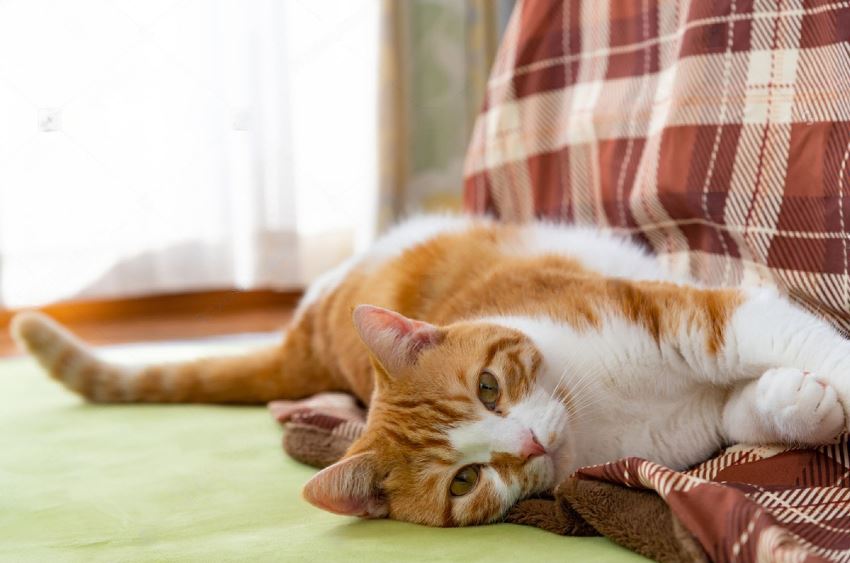How to Help Your Cat Limping Back Leg to Health | When a cat, who appears to be healthy, starts to drag one back leg, what would you do? If your instinct is to take it to the vet, that is probably a good idea. However, if it continues to limp and you are worried about an infection setting in, you could use some natural remedies to help it heal. Treating an injury when it is still sore can help prevent it from getting worse. Here are some home remedies for cats with a dragging back leg that could use some extra TLC.
1. Massage Your Cat’s Back:
There are many benefits to massaging your cat’s back. It can help relax your cat and release some tension, and it also helps to work out any knots or kinks that might be causing the issue. This can help to relieve your cat’s discomfort, encourage blood flow, and improve overall muscle tone. Massaging a cat is easier than you think. You can use your thumb and forefinger to carefully lift each leg and place it on the bed or surface you are using for the massage.
2. Keep Your Cat Active:
Just like people, a cat’s body is designed to keep itself as active as possible. If your cat is still limping and experiencing pain, this can make the injury worse. If possible, encourage your cat to walk or run around so that it gets its muscles moving and keeps the blood flowing. This will help your cat heal faster.
3. Use Anti-inflammatory Medication:
If your cat’s injury is a result of an allergic reaction or intense pain, then an anti-inflammatory medication could be all you need to get your cat feeling better. If your cat seems to be in pain from something other than the injury, an anti-inflammatory could make a big difference.
4. Apply Heel Balm:
Heel Balm can be applied directly to your cat’s sore spot to relieve some of the pressure. This is often all it takes to help relieve the pain and get your cat’s energy back. There are many different types of heel balm, so check out reviews to find one that your cat will like best.
5. Get Some NSAIDs:
If your cat is having trouble moving its back leg, you might be able to get some relief from over-the-counter medications such as ibuprofen or Naproxen. Give your cat medication at the first sign of discomfort and follow the instructions on the label to determine how long it should be taken. Always make sure to follow the directions carefully.
6. Have Your Cat Checked Out by the Vet:
If your cat’s injury does not improve after a few days, consider taking it to the vet for a check-up. Your vet can examine your cat, diagnose the problem, and possibly recommend a treatment. A few quick tests and some blood work can help rule out other problems that could be causing the symptoms.
7. Keep Your Cat Warm:
If your cat has a temperature or is feeling cold, it might be trying to pull away from you. To encourage your cat to stay near you, put it in a warm place such as a cardboard box lined with a towel. The warmth will help comfort your cat and encourage it to allow you to continue caring for its wounds.
8. Use a Heating Pad:
A heating pad can also be helpful to soothe your cat and help it to heal. Many cats find a hot pad to be incredibly comforting, especially when combined with a gentle massage. The pad should be as hot as your cat can tolerate without screaming in pain. There are also electrically heated pads that plug into the wall and have controls that you can set anywhere from lukewarm to downright hot.
9. Keep Your Cat Hydrated:
If your cat is limping, it is more likely to become dehydrated. Make sure to keep a bowl of water near your cat’s bed and give it regular sips. Monitor your cat for signs of dehydration and correct the situation if necessary.
10. Give Your Cat Pain Relievers:
If your cat is having issues with pain, whether from an injury or from old injuries that have not healed, you might be able to help by giving it some pain reliever. As mentioned above, many cats find pain relief provided by a gentle massage to be extremely soothing. Ibuprofen and Naproxen are two of the most common medications prescribed for pain relief in cats.
Other pain relievers you might want to consider giving your cat include Clomicalm (clonidine), Rimadyl (piroxicam), Cytosport Caffeine Tablets (caffeine, guaifenesin), and Promedol/Pepcid/Nytril (acetaminophen).
Why Is My Cat Limping Back Leg?

Cats are very independent creatures and do not like to be handled. They also have a very strong will to live, which is why they hide their injuries from you. Overwhelmed by the constant nagging of your cat, it will eventually surrender to its pain and become paralyzed on one of its back legs.
This leads to your cat falling down from a height and hitting the ground, causing minor damage to its back leg. The resulting injury makes your cat limp and unable to walk properly, which is why you will see it dragging the back leg on the floor.
How to tell if your cat is in pain If you observe that your cat is dragging its back leg, it is a sure sign that it is in pain. In addition to this behavior, there are several other signs that can indicate your cat is in pain:
- Loss of appetite and/or acting depressed
- Slow movement
- Hiding
- No longer using the litter box (if your cat was before)
You do not have to guess; take your cat to the vet right away if you notice any of these symptoms.
How To Prevent Your Cat From Limping
Whether you live with a cat or have one you share your home with, chances are good that you’ve seen your kitty limping. It’s not an uncommon occurrence and it may be something as simple as a minor sprain or something more serious such as an injury.
Knowing what to do to help your cat is an important part of pet parenting and knowing how to prevent your cat from getting injured in the first place is just as important. Here are some things you can do to keep your kitty healthy and happy:
1. Have your cat neutered:
Unneutered male cats tend to roam, fight and fight and fight until they injure themselves or someone else in the process. If your cat is outdoors, make sure it has identification tags, an up-to-date rabies vaccine, and a microchip that includes its registration number. Neutering a cat will decrease roaming, fighting and spraying behaviors, as well as help, control your cat’s natural instinct to mark its territory.
2. Consider getting your cat a tag:
Having a tag on your cat will help you get it back if it ever goes missing, which is an extremely common occurrence with cats. A lot of people believe that cats can’t be stolen, but according to the Humane Society of the United States, as many as 1.5 million cats and dogs are stolen in the U.S. every year. Having a tag will make it easier for you to get your cat back if it is taken and give you peace of mind knowing it is safe.
3. Learn how to catch your cat:
In the event that your cat does go missing, knowing how to catch it is an important skill to have. You might be able to catch your cat before it has a chance to run off, or you can learn some of the tricks other people have used if your cat proves hard to catch.
4. Make sure your cat is up-to-date on vaccines:
Even the most healthy cats need routine vaccines to stay healthy. Some of the vaccinations that are important for your cat to have include rabies, feline leukemia, and feline Panleukapause. If you notice any signs of illness or injury in your cat, be sure to get it checked out by a veterinarian as soon as possible.
5. Keep your cat inside:
The risk of your cat getting injured outdoors is too high when compared to the risk of an injury indoors. If you do take your cat outside, make sure it has identification tags, up-to-date vaccines, and a microchip.
When Should I Take My Cat to The Vet For Limping?

When a cat is limping, the first thing you may do is take it to the veterinarian. However, this is a common mistake. If your cat is not in immediate distress, waiting to see a veterinarian could mean the difference between life and death. In order to help your cat heal faster and prevent further injury, here are some tips to follow:
- If your cat is showing any signs of discomfort, such as vocalizing, excessive licking, rubbing, or apparent pain when it walks, then go to the veterinarian immediately. You should also alert your veterinarian if you notice any of the following symptoms.
- If your cat has only sustained minor injuries, such as a scrape or a small fracture, then a trip to the veterinarian will not be necessary. Keep an eye on your cat’s symptoms and if they do not worsen, then you can safely wait.
- If your cat has sustained an injury that involves bones or joints, then you should take it to the veterinarian immediately. Examples of this include: sprains, bruises, broken bones, ruptured discs, and torn ligaments.
- If your cat is suffering from a serious injury such as cancer or an anorexic state, then you should also take it to the veterinarian. However, if it is only exhibiting minor symptoms, such as lethargy, diarrhea, vomiting, or loss of appetite, then it is not urgent.
What To Do If Your Cat Is In Pain
As mentioned above, many cats try to hide their pain by acting normal. If you suspect your cat is in pain, then here are some ways to help it feel better:
- Make a comforting noise – such as a meowing sound or humming to help relieve anxiety.
- Allow your cat to rest – if possible, keep your cat away from the area where it is experiencing pain.
- Use a heating pad – this will help to increase blood flow and provide warmth to your cat.
- Keep your cat quiet – distractions are often stressful for cats and may lead to aggressive behaviors.
- Apply cold packs to the area where your cat is experiencing pain – this will decrease inflammation and also help to relieve discomfort.
- Give your cat pain medication – if your cat’s injury involves bones or joints, then an NSAID such as aspirin or ibuprofen will help reduce pain. However, keep in mind that cats are very sensitive to pain medications, so you should only give them a small amount of medication at a time.
Watch the tutorial
Conclusion: How to Help Your Cat Limping Back Leg to Health
By taking the time to assess your cat’s symptoms and providing comfort, you can help it heal more quickly. Although it is true that most cats can be treated for their ailments at home, it is better to be safe than sorry. As such, if you notice any of the above signs in your cat, then you should take it to the veterinarian immediately.
Can Dogs Eat Bread? Read This Before Feeding It To Them
Can Dog Eat Pineapple? Pineapple, the Fruit vs Pineapple, the Treat
Can Dog Have Beef Jerky? The Truth About This Healthy Snack
Can Dog Have Broccoli? – Everything You Need to Know
Can Dogs Eat Eggplant? The Truth, Explained
Can Dog Eat Eggs – Everything You Need to Know About Eggs and Your Dog

